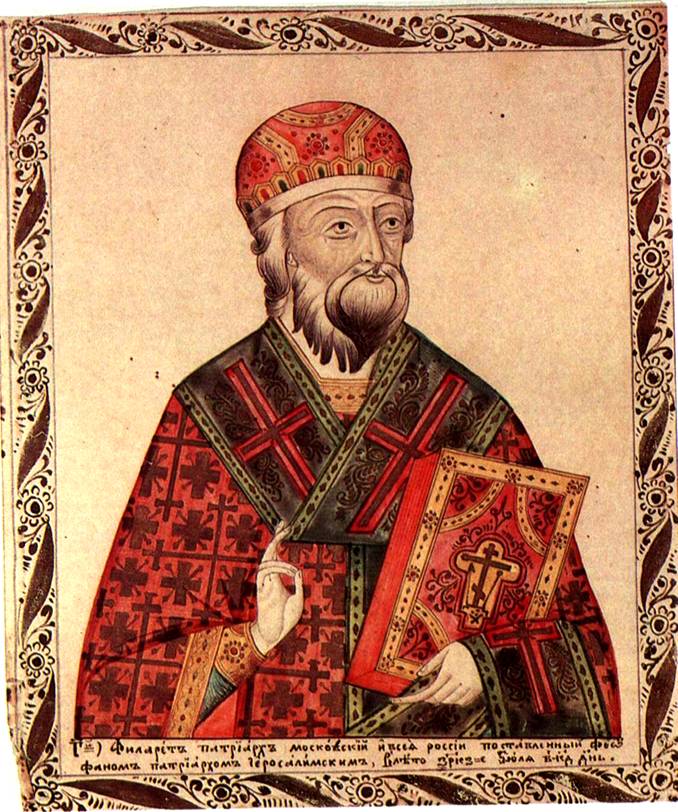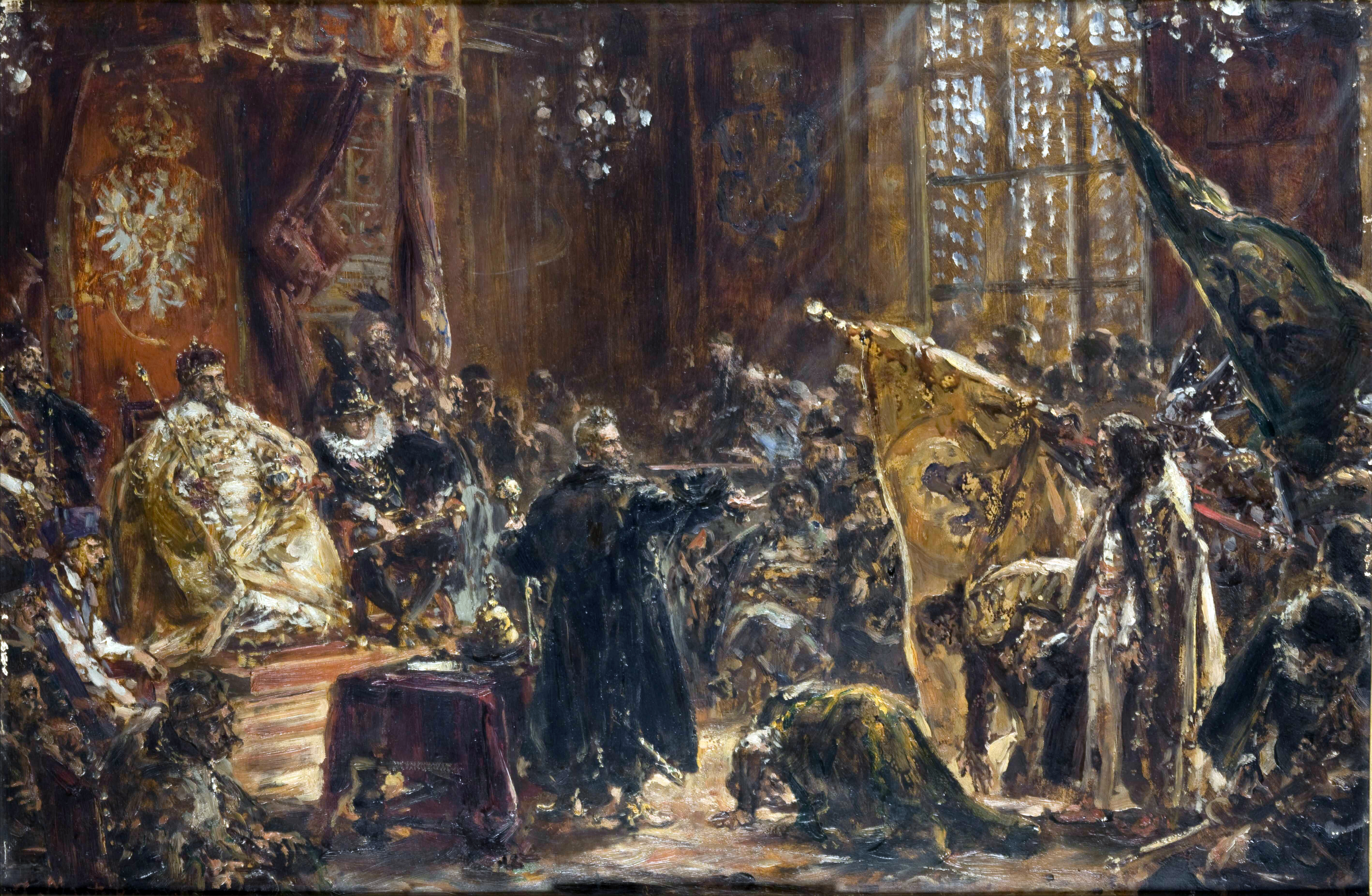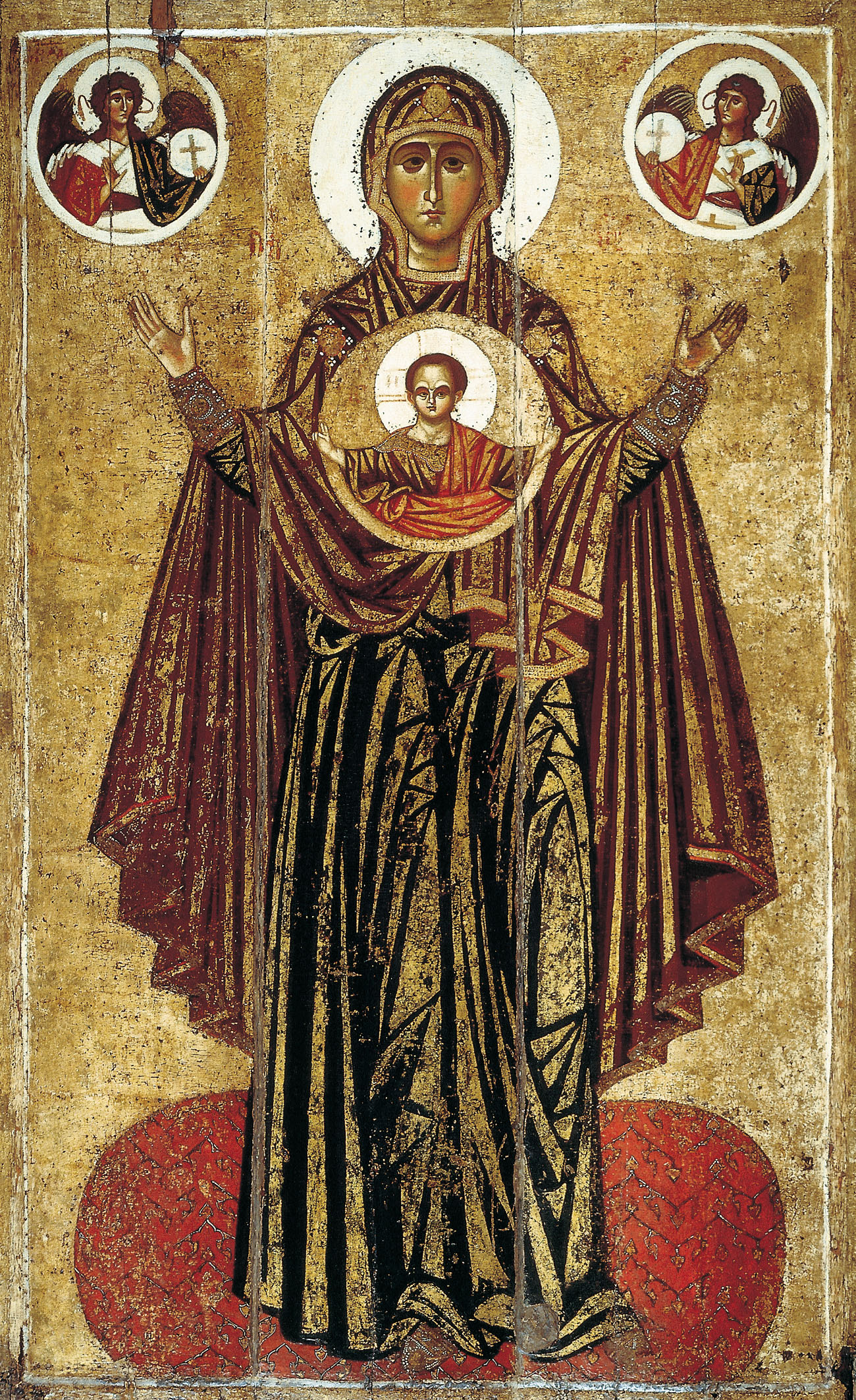|
Germogen
Hermogenes, or Germogen (russian: Гермоге́н) (secular name Yermolay) (before 1530 – 17 February 1612) was the Patriarch of Moscow and all Russia from 1606. It was he who inspired the popular uprising that put an end to the Time of Troubles. Hermogenes was glorified by the Russian Orthodox Church in 1913. At the Holy Synod of 1589, which established the patriarchy in Moscow, Hermogenes was appointed Metropolitan of the newly conquered city of Kazan. During the following two decades, he gained renown for a number of Muslim Volga Tatars converted to Eastern Orthodoxy. In 1606, Hermogenes was summoned by False Dmitry I to take part in the Senate recently instituted in Moscow. There he learnt about the tsar's design to marry a Roman Catholic woman, Marina Mniszech, and firmly declared against such an alliance. At that he was exiled from the capital, only to return with great honours several months later, when the false tsar had been deposed, and Patriarch Ignatius followe ... [...More Info...] [...Related Items...] OR: [Wikipedia] [Google] [Baidu] |
Prokopy Lyapunov
Prokopy Petrovich Lyapunov () (Isady, Grand Duchy of Moscow; Grand Duchy of Ryazan became a part of Grand Duchy of Moscow in 1521 and Moscow shouldn't be confused as a birth place which is located to the east of Old Ryazan, in a village that survived to this day b. ? — July 22, 1611;Most sources agree that he died no later than August 1, 1611 Tsardom of Russia) was a prominent 17th century Russian nobleman (dvoryanin), voivode (military chieftain) of, allegedly, a Rurikid origin who practically became a head of Pereyaslavl-Ryazansky lands nobility in the end 1590s; he took part in wars during power vacuum in succession crisis that happened in early 1598 as result of confusion about legitimate heir apparent following death of Feodor I, nobility infighting, war declared by Polish–Lithuanian Commonwealth (PLC) in 1605, and exhaustive Tatar raids; most famously he is remembered for organizing and leading the first unsuccessful uprising against occupation of Moscow of 1610 by ... [...More Info...] [...Related Items...] OR: [Wikipedia] [Google] [Baidu] |
Ignatius Of Moscow
Ignatius (russian: link=no, Игнатий, el, Ιγνάτιος) (1540–1620) was a Russian Orthodox bishop of Greek descent who was the second Patriarch of Moscow and All Russia in 1605–1606, even though his status is now disputed and he is frequently omitted from the list of Patriarchs of Moscow by the Russian Orthodox Church. Ignatius was reported to be of Cretan descent. He came to Russia in 1595 as a member of an ecclesiastic mission, sent by the Patriarch of Constantinople. He took part in the coronation of Boris Godunov. In the early 17th century, Ignatius was appointed Archbishop of Ryazan. After the death of Godunov, he expressed support to False Dmitriy I and, even before the pretender reached Moscow, was swearing in his supporters in Tula. On 30 June 1605, Ignatius was elected patriarch by the council of bishops to replace Patriarch Job, who was sent into exile for refusing to acknowledge the pretender's rights for Russian throne. Ignatius performed the coro ... [...More Info...] [...Related Items...] OR: [Wikipedia] [Google] [Baidu] |
Patriarch Filaret Of Moscow
Feodor Nikitich Romanov (russian: Фео́дор Ники́тич Рома́нов, ; 1553 – 1 October 1633) was a Russian boyar who after temporary disgrace rose to become patriarch of Moscow as Filaret (russian: Филаре́т, ), and became de facto ruler of Russia during the reign of his son, Mikhail Feodorovich. Biography The second son of the prominent boyar Nikita Romanovich, Feodor was born in Moscow and was the first to bear the Romanov surname. During the reign of his first cousin Feodor I (1584–1598), young Feodor Romanov distinguished himself both as a soldier and a diplomat, fighting against the forces of John III of Sweden in 1590, and conducting negotiations with the ambassadors of Rudolf II, Holy Roman Emperor from 1593 to 1594. He was made a boyar in 1583. On the death of the childless tsar, he was the popular candidate for the vacant throne; but he acquiesced in the election of Boris Godunov, and shared the disgrace of his too-powerful family three yea ... [...More Info...] [...Related Items...] OR: [Wikipedia] [Google] [Baidu] |
Time Of Troubles
The Time of Troubles (russian: Смутное время, ), or Smuta (russian: Смута), was a period of political crisis during the Tsardom of Russia which began in 1598 with the death of Fyodor I (Fyodor Ivanovich, the last of the Rurik dynasty) and ended in 1613 with the accession of Michael I of the House of Romanov. It was a time of lawlessness and anarchy following the death of Fyodor I, a weak and possibly intellectually disabled ruler who died without an heir. His death ended the Rurik dynasty, leading to a violent succession crisis with numerous usurpers and false Dmitrys (imposters) claiming the title of tsar. Russia experienced the famine of 1601–03, which killed almost a third of the population, within three years of Fyodor's death. Russia was occupied by the Polish–Lithuanian Commonwealth during the Polish–Russian War (also known as the ''Dimitriads'') until it was expelled in 1612. It was one of the most turbulent and violent periods in Russian history. ... [...More Info...] [...Related Items...] OR: [Wikipedia] [Google] [Baidu] |
Patriarch Of Moscow And All The Rus'
The Patriarch of Moscow and all Rus' (russian: Патриарх Московский и всея Руси, translit=Patriarkh Moskovskij i vseja Rusi), also known as the Patriarch of Moscow and all Russia, is the official title of the Bishop of Moscow who is the primate of the Russian Orthodox Church. It is often preceded by the honorific "His Holiness". While as the diocesan bishop of the Moscow diocese he has direct canonical authority over Moscow only, the Patriarch has a number of church-wide administrative powers within and in accordance with the charter of the Russian Orthodox Church. [...More Info...] [...Related Items...] OR: [Wikipedia] [Google] [Baidu] |
Moscow Kremlin
The Kremlin ( rus, Московский Кремль, r=Moskovskiy Kreml', p=ˈmɐˈskofskʲɪj krʲemlʲ, t=Moscow Kremlin) is a fortified complex in the center of Moscow founded by the Rurik dynasty. It is the best known of the kremlins (Russian citadels), and includes five palaces, four cathedrals, and the enclosing Kremlin Wall with Kremlin towers. In addition, within this complex is the Grand Kremlin Palace that was formerly the Tsar's Moscow residence. The complex now serves as the official residence of the President of the Russian Federation and as a museum with almost 3 million visitors in 2017. The Kremlin overlooks the Moskva River to the south, Saint Basil's Cathedral and Red Square to the east, and the Alexander Garden to the west. The name "''Kremlin''" means "fortress inside a city", and is often also used metonymically to refer to the government of the Russian Federation. It previously referred to the government of the Soviet Union (1922–1991) and its high ... [...More Info...] [...Related Items...] OR: [Wikipedia] [Google] [Baidu] |
Vasily IV
Vasili IV Shuisky (russian: Василий IV Иванович Шуйский, ''Vasiliy IV Ivanovich Shuyskiy'', c. 155212 September 1612) was Tsar of Russia between 1606 and 1610 after the murder of False Dmitri I. His rule coincided with the Time of Troubles. He was the only member of House of Shuisky to become Tsar and the last member of the Rurikid dynasty to rule as tsar. Life He was a son of Ivan Andreyevich Shuisky. Born Prince Vasili Ivanovich Shuisky, he descended from sovereign princes of Nizhny Novgorod and was a 20th-generation male-line descendant of the 9th-century Varangian prince Rurik. Vasili Ivanovich was one of the leading boyars of the Tsardom of Russia during the reigns of Feodor I () and Boris Godunov (). In the court intrigues of the Time of Troubles (1598–1613), Vasily and his younger brother Dmitry Shuisky usually acted together and fought as one. It was Shuisky who, in obedience to the secret orders of Tsar-to-be Boris, went to Uglic ... [...More Info...] [...Related Items...] OR: [Wikipedia] [Google] [Baidu] |
Panagia
Panagia ( el, Παναγία, fem. of , + , the ''All-Holy'', or the ''Most Holy''; pronounced ) (also transliterated Panaghia or Panajia), in Medieval and Modern Greek, is one of the titles of Mary, mother of Jesus, used especially in Eastern Catholicism and Orthodox Christianity. Most Greek churches dedicated to the Virgin Mary are called ''Panagia''; the standard western Christian designation of "St. Mary" is rarely used in the Orthodox East, as Mary is considered the holiest of all created beings and therefore of higher status than the Saints. Iconography ''Panagia'' is also the term for a particular type of icon of the Theotokos, wherein she is facing the viewer directly, usually depicted full length with her hands in the ''orans'' position, and with a medallion showing the image of Christ as a child in front of her chest. This medallion symbolically represents Jesus within the womb of the Virgin Mary at the moment of the Incarnation. This type of icon is also called t ... [...More Info...] [...Related Items...] OR: [Wikipedia] [Google] [Baidu] |
Donkey
The domestic donkey is a hoofed mammal in the family Equidae, the same family as the horse. It derives from the African wild ass, ''Equus africanus'', and may be classified either as a subspecies thereof, ''Equus africanus asinus'', or as a separate species, ''Equus asinus''. It was domesticated in Africa some years ago, and has been used mainly as a working animal since that time. There are more than 40 million donkeys in the world, mostly in underdeveloped countries, where they are used principally as draught or pack animals. While working donkeys are often associated with those living at or below subsistence, small numbers of donkeys or asses are kept for breeding or as pets in developed countries. A male donkey is known as a ''jack'' or ''jackass'', a female is a ''jenny'' or ''jennet'', and an immature donkey of either sex is a '' foal''. Jacks are often mated with female horses (mares) to produce '' mules''; the less common hybrid of a male horse (stallion) and j ... [...More Info...] [...Related Items...] OR: [Wikipedia] [Google] [Baidu] |
Ivan Bolotnikov
Ivan Isayevich Bolotnikov (russian: Ива́н Иса́евич Боло́тников; 1565–1608) headed a popular uprising in Russia in 1606–1607 known as the Bolotnikov Rebellion (Восстание Ивана Болотникова). The uprising formed part of the Time of Troubles in Russia. Early life Describing Bolotnikov, Paul Avrich states, "Contemporaries depict him as tall and powerfully built and as an intelligent and energetic leader." Bolotnikov was a slave of Prince Andrei Teliatevsky, before running away to join the Cossacks along the steppe frontier between Muscovy and the Crimean Khanate. Captured by the Crimean Tatars, he was sold into slavery as a helmsman for a Turkish galley. Liberated in a sea battle by German ships, he was taken to Venice. Journeying back to Muscovy, he passed through Poland, where he heard tales of the Tsar Dmitri. This led Bolotnikov to Sambor, where he met Mikhail Molchanov. Molochanov was part of the group who had murdered Feodor ... [...More Info...] [...Related Items...] OR: [Wikipedia] [Google] [Baidu] |
Roman Catholics
The Catholic Church, also known as the Roman Catholic Church, is the largest Christian church, with 1.3 billion baptized Catholics worldwide . It is among the world's oldest and largest international institutions, and has played a prominent role in the history and development of Western civilization.O'Collins, p. v (preface). The church consists of 24 ''sui iuris'' churches, including the Latin Church and 23 Eastern Catholic Churches, which comprise almost 3,500 dioceses and eparchies located around the world. The pope, who is the bishop of Rome, is the chief pastor of the church. The bishopric of Rome, known as the Holy See, is the central governing authority of the church. The administrative body of the Holy See, the Roman Curia, has its principal offices in Vatican City, a small enclave of the Italian city of Rome, of which the pope is head of state. The core beliefs of Catholicism are found in the Nicene Creed. The Catholic Church teaches that it is the on ... [...More Info...] [...Related Items...] OR: [Wikipedia] [Google] [Baidu] |








.jpg)